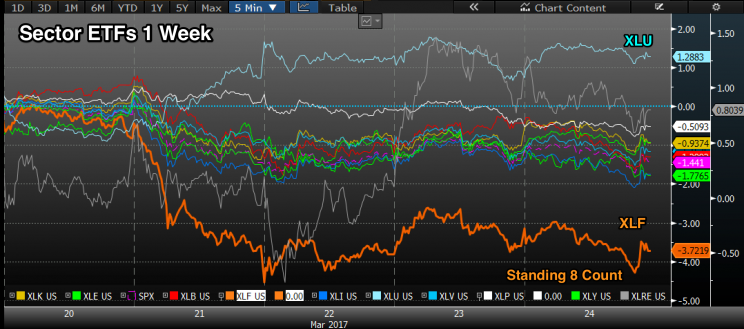Trump trade takes a standing 8 count
The Trump trade isn’t dead, but it’s safe to say it took a standing 8 count last week. Banks were some of the hardest hit securities on Black Tuesday. The one-week performance chart of SPDR Sector ETFs show the shift in mindset. The SPDR Financial ETF (XLF) came in dead last with other Trump trades like Industrials (XLI) not far behind. Yield sensitive Utilities (XLU) performed best putting in a strong week.

Some data suggests that loan growth slowed in December and January. In addition, any further decline in relative performance might force those late to the party to unload recent purchases.
The disconnect between investor perception and the actual timeline of administration policy came home to roost last week. The large selloff Tuesday, ending in a losing week, was driven by mounting concern that market-friendly policy, including tax reform, repatriation and a rollback of regulatory overreach, is going to take longer than thought.
The failure of the GOP healthcare bill widens the already large split within the party, which makes subsequent legislation more difficult to pass. I suspect Trump will now focus on an agenda that has at least some bipartisan support. The biggest risk is policy dilution. Watered-down legislation may be the only bills to get through Congress. The administration may choose to focus on regulations and policy initiatives that don’t require support from Congress.
As long as investors expect interest rates to move in a general path higher, financials will likely be okay. However, if yields break support or the perception of policy reform deteriorates further, the bull case for the sector will hit a wall if it hasn’t already.
Good news & bad news
The good news is that despite valuations, which are a bit stretched, fundamentals are still good with most of the important economic data points heading in the right direction. The bad news is the technical picture for the market, which continues to deteriorate. Previous posts have talked about what may have been an exhaustion gap earlier in the month and an advance/decline line starting to roll over. This week adds the NYSE Bullish Percent Index moving into a column of zeros — an indication that more than 6% of stocks have transitioned to a point and figure sell signal.

What is the bond market saying?

The all-important 10-year yield has been stuck in a range since late last year. It remains to be seen whether it is just consolidating before its next march higher or another move toward last year’s lows. For the latter to happen, economic deterioration would have to move front and center, a prospect I give low odds at present. The biggest anchor for yields is sovereign debt from large developed societies like Europe and Japan still pledging allegiance to negative rates as a solution to their economic shortcomings. Until that dynamic changes, it is difficult for US yields to meaningfully breakout.
Despite the narrow trading range, 10-year yields can be an important indicator of market direction. A breakdown approaching 2% would likely mean the economic case for higher equity prices is unraveling. A breakout above 2.65% puts us on the path to 3% and a bull market back on track.
* At the time of this article some funds managed by David Nelson were long SPY and XLU.
————————————————-
Please contact your Belpointe investment advisor representative if there are any changes in your financial situation or investment objectives.
Investment advice is offered through Belpointe Asset Management, LLC. Past performance is no guarantee of future returns. Insurance products are offered through Belpointe Insurance, LLC and Belpointe Specialty Insurance, LLC. It is important to read our email disclosures available at this link: http://belpointe.com/disclosures.
